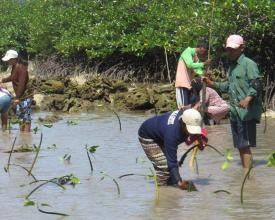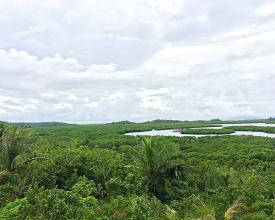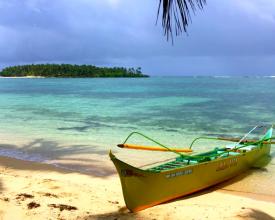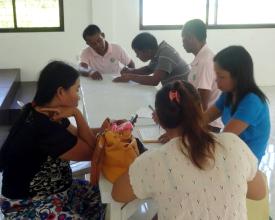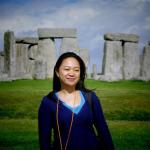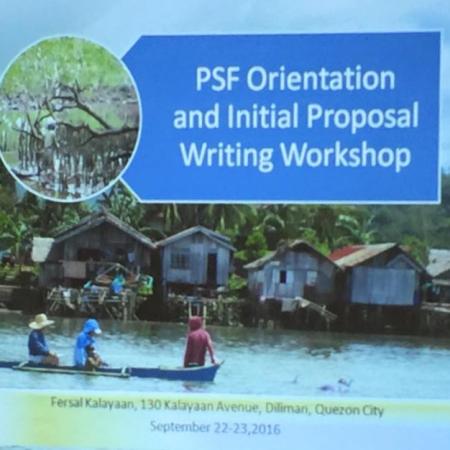
Engaging Multi-sectoral Partners for Climate Resilience
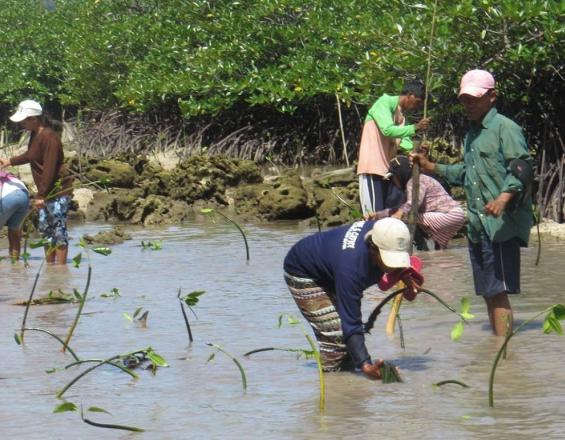
Recognizing the island’s vulnerability to geological and climate change-related hazards and hazards brought about by proliferation of unsustainable and destructive practices, the local government unit (LGU) of Siargao Island focused on developing and strengthening partnerships with the communities, private sector, academia and non-government organizations in order to have a comprehensive knowledge and understanding of the impacts of climate change and to develop and implement adaptation strategies. Theirs is a story of how different sectors worked together to analyze and address the impacts of the different hazards they are facing and how they collaborated to take advantage of an opportunity that resulted in the winning of an 80-million-peso grant for the establishment of a Climate Field School for Farmers and Fisherfolk.
Context
Challenges addressed
Environment: Illegal fishing and unregulated mangrove cutting was widely practiced in Siargao Island putting their marine resources at risk of depletion. The involvement of fishing communities, the sector most dependent on healthy marine and coastal ecosystem for food and livelihood, was effective in the enforcement of fisheries law and ordinances and in the establishment and strengthening of marine protected areas. The availability of alternative livelihood provided by the LGU, SIKAT and other government agencies also helped curb these illegal practices.
Socio-economic: Communities in Siargao Island, many live below the poverty line, are mainly engaged in farming, fishing and tourism, ventures which are all dependent on available natural resources. The awarding of the grant for a climate field school would give the farmers and fishermen the tool to analyze the effect of climate change and adapt their practices.
Location
Process
Summary of the process
Having the SIPLAS, which identifies the vulnerability of Siargao is the jump-off point by which the stakeholders (local government, non-government, academia and communities were able to identify their adaptation strategy. The second building block ( organizing and building the capacity of people’s organization and identifying partners) is important to ensure that the stakeholders have the capacity to carry out the strategies. The third building block ( educating communities on the hazards of unsustainable fishing practices and climate change) is necessary so that there is a common understanding about why the strategies have been crafted as such. The fourth building block (identifying new partners) ensures that programs are run by partners with relevant experience and capacity. All these blocks are held together by the collaborative relationship among all the stakeholders.
Building Blocks
Vulnerability Analysis
Assessing vulnerability is a crucial step in order to identify the risks and come up with appropriate solution. Siargao’s revised Siargao Island Protected Landscape and Seascape Plan takes into consideration the geologic hazards, climate change related hazards as well as the hazards brought about by illegal fishing, unregulated cutting of mangroves and other destructive practices. The farming and fishing communities of Siargao Island are highly dependent on available natural resources and coastal villages in particular are exposed to climate related hazards. There is therefore a pressing need for Siargao to develop a comprehensive understanding of the impacts of climate change, both on the environment and on its socio-economic development, as well as measures to manage these impacts.
Understanding the risks and vulnerabilities is also necessary in identifying the organizations and people who have the technical skills and capability to assist in the identification of adaptation strategies. Sentro Para sa Ikauunlad ng Katutubong Agham at Teknolohiya (SIKAT), for example, was identified because of their significant experience in community-based coastal resource management and in community-based disaster risk management.
Enabling factors
- Availability of Siargao Island Protected Landscape and Seascape Plan which takes into consideration the geologic hazards, climate change related hazards as well as the hazards brought about by illegal fishing, unregulated cutting of mangroves and other destructive practices.
- Participatory Hazard Assessments, Capacity and Vulnerability Assessments, and Climate Change Adaptation planning conducted in coastal communities.
Lesson learned
Coastal communities should be involved in vulnerability assessment taking into consideration the differentiated impacts of hazards to men and women fishers.
Organizing and building the capacity of people’s organization
The local government unit (LGU) in Siargao Island recognized the importance of involving the communities in the implementation of adaptation strategies to ensure sustainability, and for the communities to own the responsibility in the care of their natural resources. The mayor of Del Carmen organized fish wardens from among the local fisherfolk, trained and deputized them to enforce the fisheries laws and ordinances. He also organized people’s organization at the village level and trained and deputized them to manage the marine protected areas, and to carry out alternative livelihood activities. Empowering these groups , through trainings other government agencies and from Sentro Para sa Ikauunland ng Katutubong Agham at Teknolohiya (SIKAT), a non-government organization implementing community-based coastal resource management and disaster risk reduction programs meant that they will be able to effectively carry out their tasks and responsibilities with minimal supervision from the LGU, and ensure the success in the implementation of adaptation strategies.
Enabling factors
- The mayor believes in building the capacity of the community and its members and spearheaded the creation of people’s organization in all the villages in the municipality of Del Carmen.
- The willingness of the community members to volunteer and be an active member of the people’s organization
- Presence of NGO partner , with decades of experience in implementing community-based coastal resource management programs, in the municipality
- Availability of the municipal fisheries ordinance
Lesson learned
Communities play crucial role in enhancing coastal resiliency and therefore organizations from various sectors should contribute to improving the capacities of people's organizations and other resource managers.
Educating communities on the hazards of unsustainable fishing practices and climate change
By working with the people’s organizations and fish wardens, the communities were sensitized on the negative effects of illegal fishing, unregulated mangrove cutting and as well as the hazards brought about by climate change. SIKAT , a non-government organization and a member of the Locally Managed Marine Area (LMMA) Network, conducts workshops and provides support to the community organizations . They develop and distribute Information, Education, Communication (IEC) materials and distribute them to the communities to transfer knowledge and promote environment protection and conservation. Surigao State College of Technology also mobilizes their students and faculties to do climate change related researches and to develop climate-resilient technologies for fishers and farmers, aside from conducting capacity building and public awareness raising activities on climate change.
Enabling factors
- Presence of SIKAT, a non government organization with significant experience in implementing Community-based Coastal Resource Management and Community-based Disaster Risk Reduction and Management programs
- Presence of a state college in Del Carmen
Lesson learned
•It is effective to use community perceived climate change impacts in the information campaign materials , as well as documented anecdotal evidences.
Identifying new partners
The local government unit (LGU) identified the partners to work with based on their expertise and presence in the area. For the development of the proposal for funding for the establishment of the Siargao Climate Field School for Farmers and Fisherfolk, Surigao State College of Technology (SSCT) was identified as implementing partner. SSCT has a campus in Del Carmen and they conducted consultations with farmers and fishers as they developed the proposal. SIKAT, an NGO experienced in implementing community-based coastal resource management programs, and other NGOs provided valuable input to the proposal.
As implementing partner, SSCT will incorporate Climate Field School's module in their related programs such as Bachelor of Science in Fisheries and Bachelor of Agricultural Technology. The climate field school module would include modules on understanding and using weather forecast in decision making which makes the commitment made by the Philippine Atmospheric Geophysical and Astronomical Service Administration to provide resource persons for the module highly significant. The Technical Education and Skills Development Authority and other academic institutions are also being tapped to conduct competency exams and to monitor results, respectively.
Enabling factors
- Presence of a state college in the area, and their willigness to host the Climate Field School and integrate the modules in their programs
- Presence of NGO partner with significant experience in implementing community-based coastal resource management programs
- Willingness of PAG-ASA to commit resource persons to the Climate Field School
- The conduct of consultation activities with fisherfolk and farmers helped in the crafting of a proposal which will help address their capacity building needs
Lesson learned
The combined efforts of relevant actors within an area can result in the achievement of shared goals.
Impacts
Engaging different sectors in the climate change adaptation efforts resulted in a coordinated adaptation strategy which led to the significant decrease in illegal fishing, mangrove cutting and other illegal activities, and increased involvement in environment conservation and protection activities.
Through the facilitation of the local government unit, and the support and training provided by SIKAT, a local non-government NGO and a member of the Locally Managed Marine Area (LMMA) Network , the fish wardens and peoples organizations are able to enforce fisheries law, protect the marine protected areas and do information campaign against illegal fishing. Because of the trainings on ecology and marine protected area management, the POs and communities have developed deeper understanding of the different issues on marine conservation and are actively participating in various conservation and protection activities spearheaded by SIKAT and the LGU. The availability of alternative livelihood opportunities also made the PO members less dependent on fishing and diversified income sources. All these resulted in a significant decrease in illegal fishing activities.
Multi-sectoral engagement also enabled the local government unit to secure significant funding from the national government to set up the Siargao Climate Field School For Farmers and Fishermen.
Beneficiaries
- Communities in Del Carmen and other municipalities in SiargaoIsland
- Filipino farmers and fishermen
Story

Siargao’s Multi-Sectoral Approach to Climate Change Adaptation
Multi-sectoral climate change impact requires multi-sectoral approach. As climate change will most likely lead to significant changes in different areas of life, one sector, not even the government can single-handedly manage the impacts. Diverse perspectives from different experts coming from different sectors are required for a comprehensive analysis of the impacts and to develop appropriate adaptation strategies. That was the approach that Siargao Island has taken.
Siargao has become an arena for collaborative partnerships around the area of climate change. In 2011, Del Carmen municipality piloted the establishment of a model climate change resilient community in cooperation with the Climate Change Commission. They have developed their climate change adaptation plan which included banning of all destructive fishing gears, establishment and strengthening of marine protected areas, and reduction of fishing effort through the introduction of alternative livelihood. In partnership with NGOs, fish wardens were organized to enforce the fisheries laws and ordinances and people’s organizations created and trained for alternative livelihood and for community-based tourism. The Center for the Development of Indigenous Science and Technology or locally known as SIKAT, a non government organization and a member of Locally Managed Marine Area (LMMA) Network trained and supported the peoples organizations on community based Coastal Resource Management.
When the People's Survival Fund (PSF) was passed into law in 2012 to finance climate change adaptation strategies of LGUs, Del Carmen collaborated with the NGOs and Surigao State College of Technology (SSCT) to draft the proposal. The proposal was for an 80-million peso fund for setting up of the Siargao Climate Field School for Farmers and Fisherfolk and was prepared after community consultations and tincludes inputs from fishermen, farmers, NGOs and LGU. The proposal was one of the first 4 approved by the Climate Change Commission for the PSF.
Jonathan, SSCT Administrator was excited to find out: "How many of the students would share their knowledge with their parents who are farmers or fishermen? Would this pave the way for them to have a better life? Who wouldn’t be inspired once you see them improve their lives because of what they will be learning in school?”.

